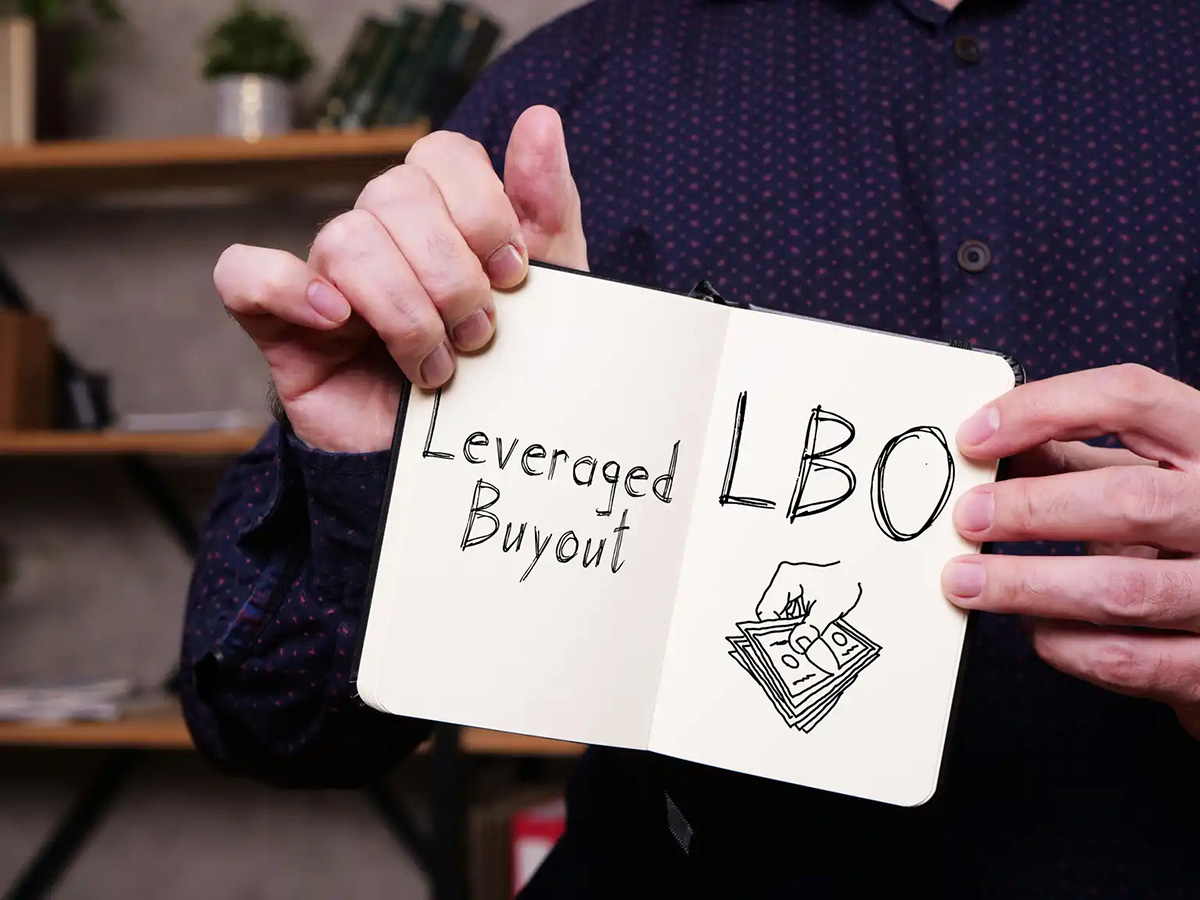

Finance
How Do Buyouts Work?
Modified: December 30, 2023
Learn how buyouts work in the world of finance and discover the ins and outs of this strategic acquisition process. Gain insights into the finance industry and its dynamics.
(Many of the links in this article redirect to a specific reviewed product. Your purchase of these products through affiliate links helps to generate commission for LiveWell, at no extra cost. Learn more)
Table of Contents
- Introduction
- What is a Buyout?
- Types of Buyouts
- Management Buyouts
- Leveraged Buyouts
- Employee Buyouts
- Process of a Buyout
- Identifying a Target Company
- Negotiating the Terms
- Due Diligence
- Financing the Buyout
- Closing the Deal
- Benefits and Risks of Buyouts
- Benefits of Buyouts
- Risks and Challenges in Buyouts
- Examples of Successful Buyouts
- Conclusion
Introduction
Buyouts are a common occurrence in the world of finance, typically involving one party taking control of another company by acquiring a significant stake or all of its shares. This transaction can have a significant impact on the target company’s operations, ownership structure, and overall business strategy. Understanding how buyouts work is essential for investors, business owners, and finance professionals.
A buyout occurs when an individual, a group of investors, or a company acquires control of another company by purchasing a majority stake or all of its outstanding shares. The purpose of a buyout can vary, ranging from strategic decision-making to restructuring or maximizing the value of an investment. Regardless of the motive, buyouts require careful planning, negotiation, and evaluation to ensure a successful outcome for all parties involved.
In this article, we will explore the different types of buyouts, the step-by-step process involved in a buyout, and the benefits and risks associated with this financial transaction. By gaining insights into the world of buyouts, you will be better equipped to make informed decisions as an investor or navigate the buyout process as a business owner.
What is a Buyout?
A buyout is a financial transaction in which one party acquires a controlling interest in another company, typically by purchasing a majority stake or all of its shares. This can be done by an individual, a group of investors, or a company seeking to take control and assume ownership of the target company.
The purpose of a buyout can vary depending on the specific circumstances. It can be driven by strategic reasons, such as gaining access to new markets, expanding product lines, or enhancing operational efficiencies. A buyout can also be motivated by financial considerations, such as seeking higher returns on investment or consolidating assets to create synergies.
Buyouts can take place in various industries and sectors, ranging from technology and healthcare to manufacturing and finance. They can involve small, privately-held companies, as well as large publicly-traded corporations. The size and complexity of a buyout can vary widely, from smaller transactions involving a single buyer and seller to multi-billion dollar deals involving multiple investors and stakeholders.
When a buyout occurs, the acquiring party gains control over the target company’s assets, operations, and decision-making processes. This often leads to changes in management leadership, ownership structure, and overall business strategy. The buyer may implement new policies, make operational changes, or even merge the acquired company with its existing business.
Buyouts can be mutually beneficial for both parties involved. The buyer can gain access to new markets, technologies, or intellectual property, while the seller can receive a significant financial return on their investment. However, buyouts can also raise concerns and challenges for stakeholders, such as employees, customers, and suppliers, who may be affected by the change in ownership.
In the following sections, we will delve deeper into the different types of buyouts, the step-by-step process involved, and the benefits and risks associated with these transactions.
Types of Buyouts
Buyouts can take several forms, depending on the parties involved and the specific circumstances surrounding the transaction. Here are three common types of buyouts:
Management Buyouts
In a management buyout (MBO), the existing management team of a company acquires a controlling stake or complete ownership of the business. This type of buyout often occurs when the management team believes they can run the company more effectively or sees an opportunity for growth that is not currently being pursued. MBOs can be funded through a mixture of equity from the management team and external financing, such as bank loans or private equity investments. This type of buyout allows the management team to take control and align the company’s strategic direction with their vision.
Leveraged Buyouts
A leveraged buyout (LBO) involves acquiring a company using a significant amount of borrowed money, typically through loans or the issuance of bonds. The target company’s assets serve as collateral for the debt, and the buyer’s intention is to use the future cash flows generated by the acquired company to repay the debt. Private equity firms often use leveraged buyouts as a way to acquire businesses and enhance their returns on investment. LBOs can result in significant growth and value creation if the acquired company performs well, but they also carry higher financial risk due to the heavy debt burden.
Employee Buyouts
An employee buyout occurs when a company’s employees purchase a majority stake or complete ownership of the business. This type of buyout is often considered as a way to preserve jobs, maintain the company’s culture, and provide financial opportunities for the employees. Employee buyouts can be structured through various financing methods, including employee stock ownership plans (ESOPs) or cooperative ownership structures. This type of buyout empowers the employees to take responsibility for the company’s success and can foster a sense of loyalty and ownership.
Understanding the different types of buyouts is crucial when analyzing specific buyout transactions and their potential implications. Each type has its own set of advantages, risks, and considerations, and it is important to assess which type aligns best with the buyer’s objectives and the target company’s circumstances.
Management Buyouts
A management buyout (MBO) is a type of buyout in which the existing management team of a company acquires a controlling stake or complete ownership of the business. In an MBO, the management team typically believes that they can effectively run and grow the company, either by implementing new strategies or capitalizing on opportunities that may not be currently pursued.
Management buyouts can be structured in various ways, but they often involve a combination of equity from the management team and external financing, such as bank loans or private equity investments. The management team will use their own funds or personal assets as a contribution to the buyout, and the remaining capital will be raised through debt or investor contributions.
One of the primary advantages of a management buyout is that the management team is intimately familiar with the company’s operations, culture, and potential for growth. As a result, they can swiftly implement their vision and strategic initiatives without the need for extensive onboarding or transitional periods. This continuity in leadership can provide stability and a seamless transition for employees, customers, and suppliers.
Another benefit of an MBO is that the management team often has a vested interest in the success of the buyout. Since their own funds are tied to the transaction, they are highly motivated to maximize the company’s value and profitability. This alignment of interests can lead to increased dedication, accountability, and performance from the management team.
However, management buyouts also present challenges and risks. One potential drawback is that the management team may lack the necessary financial resources to execute the buyout fully. In such cases, external financing becomes crucial, and securing favorable terms can be a complex process.
Additionally, management buyouts may face skepticism from external stakeholders, such as investors or lenders, who may question the management team’s ability to successfully operate the company. It is essential for the management team to present a compelling business plan and demonstrate a track record of success and sustainable growth to alleviate any doubts or concerns.
Overall, management buyouts can be an effective way for existing management teams to take control and shape the future of a company. By leveraging their knowledge and expertise, they have the potential to drive growth and create value for both themselves and the company’s shareholders.
Leveraged Buyouts
A leveraged buyout (LBO) is a type of buyout in which a significant portion of the acquisition is financed through borrowed funds. In an LBO, the acquiring entity, often a private equity firm, uses the target company’s assets as collateral to secure the necessary debt financing. The future cash flows generated by the acquired company are then used to repay the debt over time.
Leveraged buyouts can offer several advantages for both the acquiring entity and the target company. For the acquiring entity, an LBO allows them to acquire a controlling stake or complete ownership of a company without having to invest a substantial amount of their own capital. This enables them to leverage their own funds while maximizing potential returns.
One of the key benefits for the target company in an LBO is the potential for operational improvements and increased efficiency. The private equity firm or acquiring entity often brings expertise, resources, and a strategic vision to the table, which can help unlock the company’s growth potential. They may implement new management strategies, streamline operations, or invest in technologies and systems to drive profitability.
Leveraged buyouts also provide the opportunity for existing management to participate in the transaction and potentially benefit financially if the company performs well. This can incentivize and align the interests of both management and the acquiring entity, as they work towards realizing the company’s growth objectives.
However, leveraged buyouts come with certain risks and considerations. One of the primary concerns is the increased debt load placed on the acquired company. The company must generate sufficient cash flows to service the debt, which can lead to financial strain if the business underperforms or faces economic challenges.
Additionally, the extensive use of debt in an LBO can limit the acquiring entity’s flexibility in terms of capital allocation and future strategic decisions. The company may have to prioritize debt repayment over other investment opportunities or growth initiatives, which could impact long-term sustainability and competitiveness.
As with any financial transaction, thorough due diligence and careful consideration of the financial and operational risks are crucial in the case of leveraged buyouts. It is essential to assess the target company’s growth prospects, ability to generate sufficient cash flows, and industry dynamics to ensure the feasibility and success of the LBO.
In summary, leveraged buyouts offer the potential for significant financial gains and operational improvements. However, they also carry higher financial risk due to the heavy debt burden. This makes proper analysis, strategic planning, and execution critical for the success of an LBO.
Employee Buyouts
An employee buyout is a type of buyout in which the employees of a company purchase a majority stake or complete ownership of the business. This type of buyout allows the employees to become the owners and take control of the company’s operations and decision-making processes. Employee buyouts are often seen as a way to preserve jobs, maintain the company’s culture, and provide financial opportunities for the employees.
Employee buyouts can be structured in various ways, but one common approach is through an Employee Stock Ownership Plan (ESOP). An ESOP is a qualified retirement plan that allows employees to acquire shares of the company’s stock over time. As the employees contribute to the ESOP, they gradually gain ownership and become shareholders of the company.
One of the primary benefits of an employee buyout is the preservation of jobs. Employees who buy and take control of the company are more likely to prioritize job security and the well-being of their colleagues. This can lead to a more stable and supportive work environment, fostering loyalty and commitment among the employee-owners.
Employee buyouts also provide the opportunity for employees to share in the company’s financial success. As owners, they have the potential to benefit from the company’s profitability and value appreciation, typically through dividends or the sale of shares. This can create a sense of ownership and motivation among employees as they directly benefit from their contributions to the company’s success.
Furthermore, employee buyouts can help maintain the company’s distinct culture and values. With existing employees taking ownership, there is a higher likelihood of continuity in the company’s mission, vision, and operational practices. This can result in a smoother transition and limit disruptions that may occur with external ownership.
However, employee buyouts also have their challenges. One of the main obstacles is access to financing. Employees might face difficulties in securing the necessary capital to fund the buyout, especially if they lack significant personal resources or face limitations on borrowing capacity.
Additionally, employee buyouts require careful planning, effective management, and clear roles and responsibilities among the employee-owners. It is crucial to have a well-defined governance structure and mechanisms in place to ensure effective decision-making and accountability.
In summary, employee buyouts offer a unique opportunity for employees to become owners and drive the success of their company. They can preserve jobs, maintain company culture, and provide financial benefits to the employee-owners. However, careful consideration of financing options, ongoing management, and clear governance is necessary to make an employee buyout successful.
Process of a Buyout
The process of a buyout involves several key steps from identifying a target company to closing the deal. While the specifics may vary depending on the circumstances, here is a general overview of the buyout process:
1. Identifying a Target Company
The first step in the buyout process is identifying a target company. This involves conducting research and analysis to identify potential acquisition targets that align with the buyer’s strategic objectives. Factors such as industry, market position, financial performance, and growth potential are important considerations in the target company selection process.
2. Negotiating the Terms
Once a target company is identified, the buyer enters into negotiations with the target company’s owners or representatives. This stage involves discussions around the purchase price, terms of the deal, and any conditions or contingencies. Negotiating the terms can be a complex process that requires careful consideration of financial, legal, and operational aspects.
3. Due Diligence
After reaching an initial agreement on the terms, the buyer conducts due diligence to thoroughly assess the target company’s financial, legal, and operational aspects. This involves reviewing financial statements, contracts, legal documents, and any other relevant information to ensure that the buyer has a complete understanding of the target company’s assets, liabilities, risks, and potential opportunities. The due diligence process helps the buyer assess the value and feasibility of the buyout.
4. Financing the Buyout
Once due diligence is completed, the buyer must secure the necessary financing to fund the buyout. This can include a combination of equity, debt, or alternative financing methods. The specific financing structure will depend on the buyer’s financial resources, the deal terms, and the target company’s financial position. It is important to negotiate favorable financing terms and consider the impact on the buyer’s financial stability and ability to execute the buyout successfully.
5. Closing the Deal
Once the financing is secured and all necessary approvals and legal documentation are in place, the buyer and the target company proceed with closing the deal. This involves transferring ownership, finalizing contractual agreements, and fulfilling any remaining conditions or obligations. Closing the deal is a significant milestone that marks the official transfer of ownership from the seller to the buyer.
It is worth noting that the buyout process can be complex and time-consuming. It involves the collaboration of various professionals, such as financial advisors, legal counsel, and accountants, to ensure a smooth and successful transaction. Each step requires thorough analysis, careful consideration, and effective negotiation to achieve a mutually beneficial outcome for both parties involved.
Identifying a Target Company
The process of identifying a target company is a critical step in the buyout process. It involves conducting extensive research and analysis to identify potential acquisition targets that align with the buyer’s strategic objectives. The goal is to identify a company that presents a valuable investment opportunity and complements the buyer’s existing business operations or investment portfolio.
Here are some key considerations and steps involved in the process of identifying a target company:
1. Define Acquisition Criteria
The first step is to define the acquisition criteria that align with the buyer’s strategic objectives. This involves identifying the desired industry, market segment, geographic location, size, and other relevant factors. Defining clear acquisition criteria helps narrow down the search and focus on potential target companies that fit the buyer’s investment strategy.
2. Conduct Market Research
Market research is crucial in identifying target companies. This involves analyzing industry trends, market dynamics, competitive landscape, and growth prospects. Market research helps identify sectors or market segments that are ripe for consolidation or present attractive investment opportunities. It also provides insights into potential acquisition targets that may fit the buyer’s investment criteria.
3. Tap into Industry Networks
Networking within the industry is an effective way to identify potential target companies. Attending industry conferences, trade shows, and networking events can provide opportunities to connect with industry professionals, advisors, and potential sellers. Building relationships and staying connected within industry networks can lead to valuable insights and potential leads on target companies.
4. Engage Advisors
Engaging financial advisors, investment bankers, or business brokers can facilitate the process of identifying target companies. These professionals have networks, industry knowledge, and access to databases that can help identify potential acquisition targets. They can also assist in conducting preliminary research, screening potential targets, and structuring the deal.
5. Perform Financial Analysis
Financial analysis is a critical step in the target identification process. It involves evaluating the financial performance, profitability, and growth potential of potential target companies. This analysis helps determine the valuation of the company and assess its potential fit within the buyer’s investment strategy.
6. Evaluate Synergies
Assessing synergies is essential in identifying a target company. It involves evaluating how the acquisition of the target company can create value or complement the buyer’s existing operations. Synergies can include cost savings, expanded market reach, increased capabilities, or access to new technologies or product lines.
Identifying a target company requires a comprehensive approach that combines market research, industry knowledge, financial analysis, and networking. It is critical to remain patient, diligent, and proactive in the search for the right acquisition target that fits the buyer’s strategic objectives. Thoroughly evaluating potential target companies ensures a well-informed decision and increases the chances of a successful buyout transaction.
Negotiating the Terms
The negotiation stage is a crucial step in the buyout process, where the buyer and the target company’s owners or representatives engage in discussions to reach an agreement on the terms of the deal. Successful negotiations are essential for securing a mutually beneficial outcome and ensuring that the buyout aligns with the buyer’s strategic objectives. Here are important considerations and steps involved in negotiating the terms of a buyout:
1. Initial Offer
The negotiation process typically begins with the buyer making an initial offer to the target company. The offer includes the proposed purchase price, the structure of the deal (cash, stock, or a combination), and any special terms or conditions. It is important for the initial offer to be well-researched and aligned with the target company’s value and market conditions to establish a solid foundation for further discussions.
2. Assessing the Counteroffer
After receiving the initial offer, the target company’s owners or representatives will carefully assess and discuss the proposal. They may choose to accept the offer as presented, reject it outright, or more commonly, make a counteroffer. The counteroffer typically includes adjustments to the purchase price, changes to the deal structure, and additional terms or conditions that the target company deems favorable.
3. Due Diligence Review and Adjustments
If the buyer finds the counteroffer acceptable, they may proceed to conduct a due diligence review to validate the target company’s financial, legal, and operational aspects. The results of the due diligence review may impact the negotiation process, as the buyer may request adjustments to the terms based on the identified risks or opportunities. This can involve renegotiating the price, modifying the payment structure, or adding specific provisions to address the identified issues.
4. Finalizing the Terms
Throughout the negotiation process, the buyer and the target company will engage in a back-and-forth dialogue, making counteroffers and adjustments until both parties reach an agreement on the final terms. This involves finding a balance between the buyer’s desired value and the target company’s expectations. Negotiating the final terms involves considering not only the purchase price but also other factors, such as earn-outs, warranties, and representations, non-compete agreements, and transition or management contracts.
5. Legal Documentation and Closing
Once the final terms are agreed upon, the next step is to draft and execute the necessary legal documents. This includes the purchase agreement, disclosure schedules, and other documentation required to formalize the deal. It is essential to involve legal counsel to ensure that the agreed-upon terms are properly documented and legally binding. Finally, the closing process involves transferring ownership, transferring funds, and fulfilling any remaining obligations to complete the buyout transaction.
Effective negotiation skills, clear communication, and a deep understanding of the buyer’s objectives and the target company’s expectations are critical for a successful buyout. It is important to approach the negotiation process with flexibility, patience, and a willingness to seek a mutually beneficial resolution that addresses the interests and concerns of both parties.
Due Diligence
Due diligence is a critical step in the buyout process, where the buyer conducts a thorough examination and evaluation of the target company’s financial, legal, and operational aspects. The purpose of due diligence is to assess the target company’s assets, liabilities, risks, and potential opportunities, ensuring that the buyer has a comprehensive understanding of the company and can make an informed decision about the buyout. Here are the key considerations and steps involved in the due diligence process:
Information Gathering
The due diligence process starts with gathering relevant information about the target company. This may include financial statements, tax returns, operational data, customer contracts, employee records, legal documentation, intellectual property rights, and any other information relevant to the company’s operations and performance. The buyer and their team of experts will review these documents to assess the company’s financial health, market position, and legal compliance.
Financial Due Diligence
Financial due diligence involves a comprehensive analysis of the target company’s financial statements, including income statements, balance sheets, cash flow statements, and financial forecasts. The objective is to evaluate the company’s historical financial performance, cash flow generation, profitability, debt obligations, working capital management, and any potential financial risks or opportunities. Financial experts may also assess the quality of financial reporting, the validity of assumptions used in financial projections, and the identification of any potential financial red flags.
Legal Due Diligence
Legal due diligence focuses on assessing the target company’s legal and regulatory compliance, potential liabilities, and contractual obligations. This includes reviewing contracts with customers, suppliers, and other stakeholders, as well as agreements with employees, leases, licenses, and litigation history. Legal experts examine any pending lawsuits, regulatory violations, or legal issues that could impact the company’s operations or financial performance. It is crucial to identify any legal risks or contingencies that may affect the buyer’s decision to proceed with the buyout.
Operational Due Diligence
Operational due diligence involves evaluating the target company’s operational capabilities, systems, processes, and organizational structure. This includes assessing the company’s production capacity, supply chain management, sales and marketing strategies, competitive position, and human resources. The objective is to identify operational strengths, areas for improvement, potential synergies with the buyer’s operations, and any operational risks that may impact the buyout.
Risk Assessment
Throughout the due diligence process, it is crucial to assess and document the risks associated with the target company. This involves identifying potential risks in financial, legal, operational, regulatory, and industry-specific aspects. The buyer and their advisors will evaluate the severity of these risks and their potential impact on the success of the buyout. This information helps the buyer make an informed decision about whether to proceed with the buyout and can inform the negotiation process, ensuring that appropriate risk mitigation strategies and clauses are incorporated into the final agreement.
Proper due diligence is essential in mitigating risks, uncovering potential issues, and validating the value and feasibility of the buyout. By conducting a thorough examination of the target company’s financial, legal, and operational aspects, the buyer can make informed decisions throughout the buyout process and negotiate deal terms that align with their expectations and risk appetite.
Financing the Buyout
Financing the buyout is a crucial step in the overall buyout process, where the buyer secures the necessary capital to fund the acquisition of the target company. The financing structure will depend on various factors, including the size of the buyout, the buyer’s financial resources, the target company’s financial position, and the buyer’s risk appetite. Here are the key considerations and methods involved in financing a buyout:
Equity Financing
Equity financing involves using the buyer’s own funds or attracting external investors to contribute capital towards the buyout. The buyer may invest their own personal funds, partner with other individual investors, or seek investment from private equity firms or venture capitalists. Equity financing can provide the buyer with ownership control and flexibility in managing the target company, but it requires a significant upfront investment and dilutes the buyer’s ownership stake.
Debt Financing
Debt financing involves borrowing capital to fund the buyout, with the target company’s assets often serving as collateral for the debt. Common sources of debt financing include bank loans, lines of credit, mezzanine financing, or issuing corporate bonds. The buyer must demonstrate a strong credit profile to secure favorable loan terms, and the target company’s financials and assets are evaluated to determine the loan amount and interest rate. Debt financing allows the buyer to use leverage and conserve their own capital, but it increases the financial risk and has ongoing debt service obligations.
Mezzanine Financing
Mezzanine financing combines the features of both equity and debt financing. It involves issuing subordinated debt or preferred equity to investors who receive a higher return compared to traditional debt lenders. Mezzanine financing bridges the gap between traditional debt and equity financing, providing additional capital for the buyout. The terms of mezzanine financing can include flexible repayment options and potential equity participation for the investor.
Vendor Financing
Vendor financing involves the target company’s owners or shareholders providing the financing for the buyout. In this case, the buyer negotiates a payment plan with the sellers, typically structured as installments over a specified period. Vendor financing can be an attractive option, especially if the target company’s owners have a vested interest in the success of the buyout and are willing to provide favorable financing terms.
Other Sources
In certain cases, buyers may explore alternative sources of financing, such as government grants, crowdfunding, or strategic partnerships. These sources can provide additional capital or support for the buyout, depending on the specific circumstances and available opportunities. It is important to assess the suitability, feasibility, and terms of these alternative financing options to ensure they align with the buyer’s financial needs and objectives.
The financing of a buyout requires careful planning, evaluation of the available financing options, and structure to meet the specific needs of the transaction. It is important for the buyer to work closely with financial advisors, investment bankers, or lenders to determine the most appropriate financing strategy and secure the necessary funds to complete the buyout successfully.
Closing the Deal
Closing the deal is the final step in the buyout process, where the buyer and the target company proceed to complete the transaction and finalize the transfer of ownership. This stage involves several important tasks and activities to ensure a smooth and successful closure. Here are the key considerations and steps involved in closing the deal:
1. Legal Documentation
Before closing the deal, the buyer’s legal team prepares the necessary legal documentation, including the purchase agreement, disclosure schedules, and any other contractual documents specific to the transaction. These documents outline the terms of the buyout, the rights and responsibilities of both parties, and any relevant warranties or representations. It’s crucial to ensure that all legal documentation accurately reflects the agreed-upon terms and protects both the buyer and the target company.
2. Due Diligence Completion
Prior to closing, the buyer will typically complete the due diligence process. This involves thoroughly reviewing all relevant financial, legal, and operational information to evaluate the target company’s overall health, identify any potential risks or issues, and validate the value of the buyout. Completion of due diligence provides the buyer with the necessary information to proceed and finalize the deal.
3. Funds and Financing
The buyer must ensure that the necessary funds and financing are available to complete the transaction. This involves arranging for the transfer of funds to the seller as per the agreed-upon purchase price. If debt financing is involved, the buyer must coordinate with the lender to ensure that the funds are available and ready to be disbursed at the closing.
4. Transferring Ownership
During the closing process, the legal transfer of ownership occurs. The buyer and the seller complete the necessary paperwork to transfer the ownership rights from the seller to the buyer. This may involve the execution of share purchase agreements, stock transfer forms, and other legal documents specific to the type of buyout. It is crucial to ensure compliance with all applicable regulations and requirements.
5. Fulfilling Obligations
At the closing, both the buyer and the target company must fulfill any outstanding obligations and complete any necessary steps to ensure a smooth transition. This may include notifying employees, customers, suppliers, and other stakeholders about the change in ownership, updating contracts or agreements to reflect the new ownership structure, and addressing any outstanding legal or regulatory requirements. It is important to have a detailed checklist and plan in place to ensure that all necessary actions are taken.
6. Post-Closing Integration
After the deal is closed, the buyer will typically focus on the post-closing integration process. This involves integrating the target company’s operations, systems, and culture into the buyer’s existing business, aligning the strategic objectives, and implementing any necessary changes to maximize the value of the acquisition. It may involve the appointment of new management, restructuring of departments, and the integration of key processes and systems.
Closing the deal is a significant milestone that marks the successful completion of the buyout. It requires careful attention to detail, coordination, and communication between the buyer, the target company, legal advisors, and any other relevant parties. An organized and well-executed closing process helps ensure a smooth transition and sets the stage for the buyer to begin implementing their plans for the future of the acquired company.
Benefits and Risks of Buyouts
Buyouts offer both potential benefits and inherent risks for the parties involved. Understanding these advantages and challenges is crucial for investors, business owners, and finance professionals. Here are the key benefits and risks associated with buyouts:
Benefits of Buyouts
1. Strategic Expansion:
Buyouts can provide opportunities for strategic expansion into new markets, geographic regions, or product lines. By acquiring a company, the buyer gains access to its customer base, distribution channels, intellectual property, and other valuable assets, allowing for accelerated growth and market expansion.
2. Synergies and Cost Savings:
Buyouts can yield synergies and cost savings through operational efficiencies. By combining resources, eliminating redundancies, and streamlining operations, the buyer can achieve economies of scale and cost reductions. Synergies can result in increased profitability and competitive advantage.
3. Talent and Expertise:
Buyouts can bring valuable talent and expertise to the acquiring company. Acquiring skilled employees, experienced management teams, or specialized industry knowledge can enhance the buyer’s capabilities and contribute to long-term business success.
4. Access to New Technologies or Intellectual Property:
Buyouts can provide access to new technologies, patents, or intellectual property rights that can enhance product development, innovation, and competitive positioning. This can create a significant advantage in rapidly evolving industries.
5. Financial Returns:
Successful buyouts have the potential for substantial financial returns for the investors and shareholders. By acquiring undervalued companies or unlocking the value within the target company, the buyer can create opportunities for capital appreciation and favorable investment outcomes.
Risks and Challenges in Buyouts
1. Financial Risk:
Buyouts often involve significant financial commitments and leverage. The heavy debt burden can increase financial risk, particularly if the acquired company fails to generate expected revenue or cash flows. Economic downturns, unexpected market changes, or excessive debt servicing costs can present challenges for the buyer.
2. Integration Challenges:
Successfully integrating the acquired company into the buyer’s operations can be complex and challenging. Differences in culture, management styles, systems, or processes may cause disruptions and impact employee morale and customer relationships. The buyer must effectively manage the integration process to realize the anticipated synergies and benefits.
3. Regulatory and Legal Issues:
Buyouts may face regulatory scrutiny and legal challenges. Antitrust concerns, compliance issues, ongoing litigation, or disputes can complicate the transaction and potentially delay or derail the buyout process. Thorough due diligence and legal expertise are crucial in mitigating these risks.
4. Market and Industry Risks:
Buyouts can be heavily influenced by market and industry dynamics. Changes in customer preferences, technological advancements, regulatory changes, or shifts in competitive landscape can impact the success of the buyout. Buyers must carefully assess market conditions and industry trends to mitigate these risks.
5. Stakeholder Impact:
Buyouts can have significant implications for various stakeholders, including employees, customers, suppliers, and local communities. Workforce reductions, changes in employment terms, disruption in customer relationships, or strained supplier partnerships can arise, which may impact the overall success of the buyout and the buyer’s reputation.
In summary, buyouts can offer strategic benefits, financial returns, and access to valuable resources. However, they also present inherent risks and challenges that require careful assessment, planning, and implementation. Conducting thorough due diligence, managing the integration process effectively, and addressing the needs and concerns of stakeholders are essential in maximizing the advantages and mitigating the risks associated with buyouts.
Benefits of Buyouts
Buyouts can bring several advantages for the parties involved, offering strategic opportunities and potential financial gains. Understanding these benefits is crucial for investors, business owners, and finance professionals considering a buyout. Here are the key benefits of buyouts:
1. Strategic Expansion:
One of the primary benefits of buyouts is the opportunity for strategic expansion. By acquiring another company, the buyer can gain access to new markets, geographic regions, or product lines that align with their growth objectives. This strategic expansion allows for accelerated market entry, increased market share, and diversification of the buyer’s business portfolio.
2. Synergies and Cost Savings:
Buyouts often result in synergies and cost savings. By combining resources, eliminating redundancies, and streamlining operations, the buyer can achieve economies of scale and cost reductions. Synergies may include shared distribution networks, lower procurement costs, optimized production processes, or consolidated administrative functions. These efficiencies can boost profitability, enhance competitiveness, and increase shareholder value.
3. Access to Resources:
Buyouts provide access to valuable resources that can drive business growth and enhance capabilities. This includes acquiring intellectual property, patents, research and development capabilities, or proprietary technologies. By leveraging these resources, the buyer can gain a competitive edge, accelerate product innovation, and enhance their market position.
4. Talented Workforce and Expertise:
A buyout can bring highly skilled employees and experienced management teams to the buyer. Acquiring talent and expertise can enhance the buyer’s capabilities, contribute to operational excellence, and fuel innovation. The knowledge and industry-specific insights gained from the target company’s workforce can result in improved business performance and long-term success.
5. Financial Returns:
Successful buyouts have the potential for significant financial returns. By acquiring undervalued companies or identifying opportunities for value creation, the buyer can unlock the target company’s potential and generate attractive financial returns. This can translate into capital appreciation, higher dividends, or increased shareholder value.
6. Market Share Expansion:
Buyouts can enable the buyer to expand their market share by acquiring competitors or complementary businesses. This allows for a broader customer base, increased distribution channels, and a stronger market presence. As a result, the buyer can enjoy enhanced market power, negotiate better terms with suppliers, and capitalize on cross-selling opportunities.
7. Vertical Integration:
Buyouts can facilitate vertical integration, where the buyer acquires companies involved in different stages of the supply chain. Vertical integration enhances control over critical inputs, reduces dependency on external suppliers, streamlines logistics, and improves coordination between different stages of the value chain. This integration can lead to cost savings, improved efficiency, and enhanced responsiveness to market demands.
In summary, buyouts offer strategic benefits, financial returns, and access to valuable resources and expertise. By leveraging these advantages, buyers can achieve growth, enhance competitiveness, and create long-term value for their organizations and stakeholders.
Risks and Challenges in Buyouts
While buyouts offer potential benefits, they also come with inherent risks and challenges that need to be carefully managed. Understanding these risks is crucial for investors, business owners, and finance professionals considering a buyout. Here are the key risks and challenges associated with buyouts:
1. Financial Risk:
Buyouts often involve significant financial commitments and leverage. The heavy debt burden can increase financial risk, particularly if the acquired company fails to generate expected revenue or cash flows. Economic downturns, unexpected market changes, or excessive debt servicing costs can pose significant challenges for the buyer’s financial stability and profitability.
2. Integration Challenges:
Successfully integrating the acquired company into the buyer’s operations can be complex and challenging. Differences in culture, management styles, systems, or processes may cause disruptions and impact employee morale and customer relationships. The buyer must effectively manage the integration process, align the strategic objectives, and communicate effectively to ensure a smooth transition and capitalize on synergies.
3. Regulatory and Legal Issues:
Buyouts may face regulatory scrutiny and legal challenges. Antitrust concerns, compliance issues, ongoing litigation, or regulatory changes can complicate the transaction and potentially delay or derail the buyout process. It is essential to conduct thorough due diligence, engage legal experts, and ensure compliance with applicable laws and regulations.
4. Market and Industry Risks:
Buyouts can be significantly impacted by market and industry dynamics. Changes in customer preferences, technological advancements, regulatory changes, or shifts in the competitive landscape can present risks and challenges to the buyer. It is crucial to assess market conditions and industry trends to mitigate these risks, adapt to changing environments, and adjust the business strategy accordingly.
5. Stakeholder Impact:
Buyouts can have significant implications for various stakeholders, including employees, customers, suppliers, and local communities. Workforce reductions, changes in employment terms, disruptions in customer relationships, or strained supplier partnerships can arise, potentially affecting the overall success of the buyout and the buyer’s reputation. It is important to consider and address the needs and concerns of stakeholders to ensure a smooth transition and maintain positive relationships.
6. Overpayment:
There is a risk of overpayment in buyout transactions, especially if the buyer’s valuation of the target company is overly optimistic or does not adequately account for potential risks, market conditions, or future projections. Overpaying for the target company can impact the return on investment and financial performance of the buyer.
7. Environmental and Social Risks:
Buyouts may involve inherent environmental or social risks associated with the target company’s operations. These could include issues such as environmental liabilities, compliance with sustainability practices, or reputational risks stemming from unethical business practices. It is crucial to assess and address these risks to ensure long-term sustainability and alignment with environmental and social responsibilities.
Proper risk management, thorough due diligence, effective communication, and careful planning are essential in mitigating these risks and maximizing the potential for a successful buyout. By navigating these challenges effectively, buyers can position themselves for long-term growth and value creation.
Examples of Successful Buyouts
There have been numerous successful buyouts throughout history that have reshaped industries, created value, and positioned companies for long-term success. Here are a few notable examples:
1. Dell Inc.
In 2013, Dell Inc., a leading technology company, went private through a buyout led by its founder Michael Dell and private equity firm Silver Lake. The buyout allowed the company to focus on long-term strategic initiatives, make key investments, and pivot its business model to adapt to the evolving technology landscape. As a private company, Dell had the flexibility to implement changes without the pressures of quarterly earnings and shareholder demands. This successful buyout enabled Dell to transform into a comprehensive IT solutions provider and regain its competitive edge in the market.
2. WhatsApp
In 2014, Facebook acquired WhatsApp, a popular messaging app, in a landmark buyout deal worth $19 billion. The acquisition allowed Facebook to tap into the rapidly growing mobile messaging market and expand its reach among younger demographics. WhatsApp gained access to Facebook’s vast resources, user base, and technological expertise, enabling it to scale its operations, improve its infrastructure, and enhance its product offerings. The buyout was a strategic move that bolstered both companies’ positions in the social media and messaging landscape.
3. Pixar
In 2006, The Walt Disney Company acquired Pixar Animation Studios in a $7.4 billion buyout. The acquisition brought together two industry leaders, combining Disney’s iconic characters and storytelling with Pixar’s groundbreaking animation and technological prowess. The buyout allowed Disney to revitalize its animation division and regain its creative edge. Pixar, on the other hand, gained access to Disney’s robust distribution network and resources, enabling it to reach a broader global audience and continue producing critically acclaimed and commercially successful animated films.
4. Chrysler
In 2009, Italian automaker Fiat completed a successful buyout of Chrysler, which was undergoing bankruptcy proceedings at the time. This buyout allowed Fiat to enter the lucrative North American market and access Chrysler’s manufacturing capabilities and distribution channels. The combination of these two companies created a global automotive powerhouse. Through strategic restructuring and innovation, the buyout helped Chrysler overcome financial challenges, regain profitability, and position itself as a strong player in the global automotive industry.
5. Whole Foods Market
Amazon’s acquisition of Whole Foods Market in 2017 was a significant buyout that disrupted the retail and grocery industry. This $13.7 billion deal provided Amazon access to Whole Foods’ physical store presence and established customer base. It enabled Amazon to further expand into the grocery market and accelerate its brick-and-mortar retail strategy. The buyout allowed Whole Foods to leverage Amazon’s technological expertise, fulfillment infrastructure, and customer engagement capabilities, enhancing the shopping experience for its customers.
These examples demonstrate how successful buyouts can drive growth, synergies, and industry transformation. They highlight the importance of strategic vision, effective integration, and maximizing the potential synergies between the buyer and the acquired company. Successful buyouts often require careful planning, market insights, and the ability to adapt and innovate in an ever-evolving business landscape.
Conclusion
Buyouts play a crucial role in the world of finance and business, offering strategic opportunities, potential financial gains, and the ability to reshape industries. Understanding the buyout process and the associated benefits and risks is essential for investors, business owners, and finance professionals alike.
Throughout this article, we’ve explored the various stages of a buyout, from identifying a target company and negotiating the terms to conducting due diligence, financing the buyout, and closing the deal. Each step requires careful planning, analysis, and execution to ensure a successful outcome.
The benefits of buyouts are numerous, ranging from strategic expansion and synergies to financial returns and access to valuable resources. Buyouts can provide opportunities for market expansion, cost savings, access to talent and expertise, and enhanced competitiveness. They allow buyers to consolidate their operations, gain market share, and position themselves for future growth.
However, buyouts also come with inherent risks and challenges. Financial risks, integration complexities, regulatory issues, market dynamics, and stakeholder impact must be carefully managed. Thorough due diligence, effective risk management, and clear communication are crucial in mitigating these challenges and maximizing the chances of success.
It is important to learn from past successful buyouts, such as Dell, WhatsApp, Pixar, Chrysler, and Whole Foods Market, where strategic vision, effective integration, and unlocking synergies led to transformative outcomes. These examples illustrate the potential benefits and the importance of strategic decision-making, successful post-merger integration, and leveraging the strengths of both the buyer and the target company.
In conclusion, buyouts present both opportunities and challenges. Understanding the buyout process, conducting thorough due diligence, carefully evaluating risks, and planning for integration can set the stage for a successful buyout and long-term value creation. With the right strategy, execution, and management, buyouts have the potential to reshape industries, fuel growth, and create value for all stakeholders involved.














